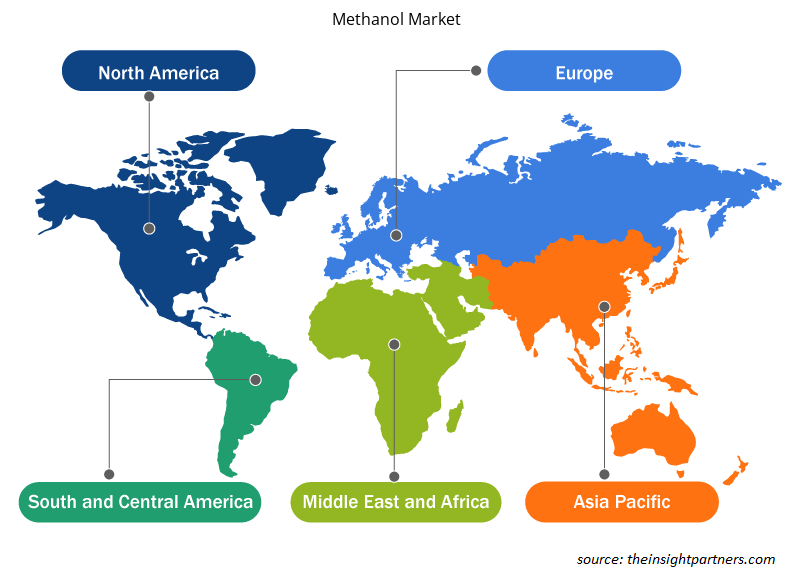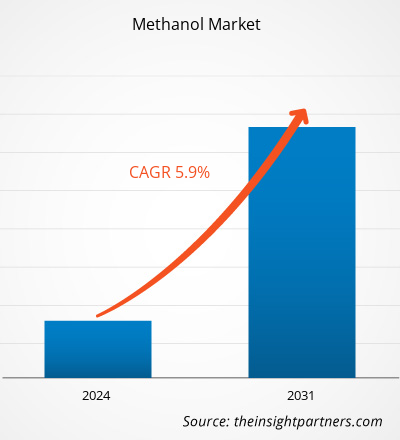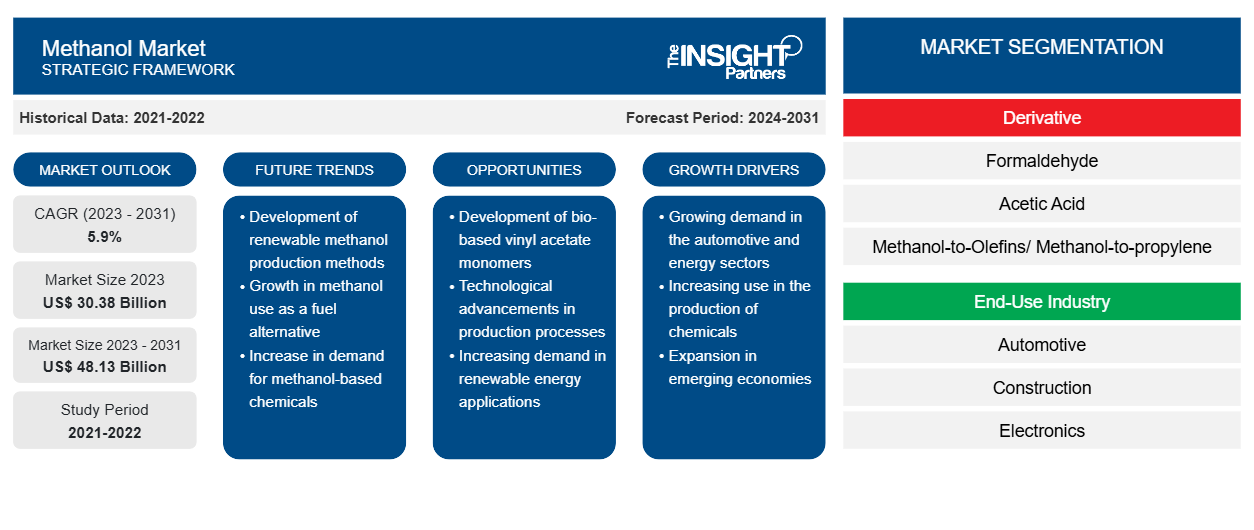Si prevede che la dimensione del mercato del metanolo raggiungerà i 48,13 miliardi di dollari entro il 2031, rispetto ai 30,38 miliardi di dollari del 2023. Si prevede che il mercato registrerà un CAGR del 5,9% nel 2023-2031. La crescente adozione del metanolo come carburante miscelato nel settore dei trasporti rimarrà probabilmente una tendenza chiave del mercato del metanolo.
Analisi del mercato del metanolo
Le attività di costruzione in rapida crescita in diversi paesi in tutto il mondo stanno guidando la crescita del mercato del metanolo. L'industria delle costruzioni è un settore industriale con le migliori prospettive per il Messico. L'industria delle costruzioni messicana sta crescendo grazie alla crescita economica e agli investimenti pubblici in progetti infrastrutturali. Il Messico si sta anche muovendo rapidamente verso attività di costruzione ecologiche e rispettose dell'ambiente. Negli ultimi anni, il settore delle costruzioni in Indonesia è stato un motore di crescita. La popolazione in rapida urbanizzazione sta guidando la domanda nel settore delle costruzioni nel paese. Inoltre, la crescita della popolazione e l'aumento della spesa pubblica per le infrastrutture sono i principali motori del mercato delle costruzioni in Indonesia.
Panoramica del mercato del metanolo
Il metanolo è il composto alcolico più semplice utilizzato come additivo nelle applicazioni industriali; è una sostanza chimica liquida infiammabile, incolore e tossica con un odore insignificante. È utilizzato in vari settori quali l'industria automobilistica, edile, elettronica, degli imballaggi, farmaceutica, vernici e rivestimenti e altri. Il metil alcol è utilizzato per produrre formaldeide, acido acetico e metilmetacrilato (MMA) ed è anche utilizzato come solvente in diverse applicazioni. Il metanolo e i suoi derivati come l'acido acetico e la formaldeide realizzati tramite reazioni chimiche sono utilizzati come materiali di base nella plastica acrilica; tessuti e fibre sintetiche utilizzati per realizzare indumenti; adesivi, vernici e compensato utilizzati nell'edilizia; e come agente chimico in prodotti farmaceutici e agrochimici.
Personalizza questo report in base alle tue esigenze
Riceverai la personalizzazione gratuita di qualsiasi report, comprese parti di questo report, o analisi a livello nazionale, pacchetto dati Excel, oltre a usufruire di grandi offerte e sconti per start-up e università
- Scopri le principali tendenze di mercato in questo rapporto.Questo campione GRATUITO includerà analisi di dati che spaziano dalle tendenze di mercato alle stime e alle previsioni.
Driver e opportunità del mercato del metanolo
Aumento dell'uso del metanolo come materia prima in varie applicazioni
Il metanolo come elemento chimico fondamentale o come combustibile, se prodotto da fonti rinnovabili, può aiutare a raggiungere gli obiettivi di decarbonizzazione. L'alcol metilico è ampiamente utilizzato nella produzione di materie plastiche, adesivi, materiali isolanti, tessuti e prodotti chimici alimentari, tra gli altri prodotti chimici e composti. La domanda di materie plastiche è in aumento a causa del crescente settore automobilistico nel mondo. Inoltre, vari derivati dell'alcol metilico sono ampiamente utilizzati nei settori farmaceutico e sanitario. Quindi, aumentare l'uso del metanolo in varie applicazioni per aumentare la crescita del mercato globale del metanolo.
Crescente attenzione verso l'uso del metanolo verde
Il metanolo verde è metanolo prodotto in modo rinnovabile e senza emissioni inquinanti. Questo composto chimico è utilizzato come combustibile liquido a basse emissioni di carbonio ed è un'alternativa promettente ai combustibili fossili nelle aree in cui la decarbonizzazione è una sfida importante. Negli ultimi anni, le alternative sostenibili e a basse emissioni di carbonio ai combustibili fossili tradizionali sono diventate una priorità assoluta. Pertanto, si prevede che la crescente attenzione all'uso del metanolo verde offrirà opportunità più redditizie per la crescita del mercato.
Analisi della segmentazione del rapporto di mercato del metanolo
I segmenti chiave che hanno contribuito alla derivazione dell'analisi di mercato del metanolo sono l'industria dei derivati e quella dell'uso finale.
- In base al derivato, il mercato del metanolo è segmentato in formaldeide, acido acetico, metanolo-olefine (MTO) / metanolo-propilene (MTP), metil-terz-butil etere (MTBE), metil-metacrilato (MMA), biodiesel, dimetil-etere (DME) e altri. Il segmento della formaldeide ha detenuto una quota di mercato significativa nel 2023.
- In base al settore di utilizzo finale, il mercato è segmentato in automotive, edilizia, elettronica, imballaggio, prodotti farmaceutici, vernici e rivestimenti e altri. Il segmento automotive ha detenuto una quota significativa del mercato nel 2023.
Analisi della quota di mercato del metanolo per area geografica
L'ambito geografico del rapporto sul mercato del metanolo è suddiviso principalmente in cinque regioni: Nord America, Asia Pacifico, Europa, Medio Oriente e Africa, Sud e Centro America.
La regione Asia-Pacifico detiene una quota maggiore del mercato globale. Si prevede che il Nord America registrerà un tasso di crescita considerevole nel periodo di previsione. Il metanolo è ampiamente utilizzato nella produzione di vari prodotti chimici e composti come materie plastiche, adesivi, materiali isolanti, tessuti e prodotti chimici alimentari. La domanda di materie plastiche è in aumento e favorisce positivamente il mercato del metanolo a causa della crescente industria automobilistica nella regione. L'industria automobilistica utilizza ampiamente polimeri plastici per produrre la struttura interna di un veicolo e altri componenti come paraurti, sistema di alimentazione, passaruota, maniglie delle portiere, pastiglie dei freni e componenti sotto il cofano. L'applicazione di componenti in plastica riduce significativamente il peso del veicolo, aumenta la sua efficienza nei consumi e soddisfa le normative ambientali relative alle emissioni di carbonio dai combustibili fossili.
Approfondimenti regionali sul mercato del metanolo
Le tendenze regionali e i fattori che influenzano il mercato del metanolo durante il periodo di previsione sono stati ampiamente spiegati dagli analisti di Insight Partners. Questa sezione discute anche i segmenti e la geografia del mercato del metanolo in Nord America, Europa, Asia Pacifico, Medio Oriente e Africa e Sud e Centro America.

- Ottieni i dati specifici regionali per il mercato del metanolo
Ambito del rapporto sul mercato del metanolo
| Attributo del report | Dettagli |
|---|---|
| Dimensioni del mercato nel 2023 | 30,38 miliardi di dollari USA |
| Dimensioni del mercato entro il 2031 | 48,13 miliardi di dollari USA |
| CAGR globale (2023-2031) | 5,9% |
| Dati storici | 2021-2022 |
| Periodo di previsione | 2024-2031 |
| Segmenti coperti | Per derivato
|
| Regioni e Paesi coperti | America del Nord
|
| Leader di mercato e profili aziendali chiave |
|
Densità degli attori del mercato del metanolo: comprendere il suo impatto sulle dinamiche aziendali
Il mercato del metanolo sta crescendo rapidamente, spinto dalla crescente domanda degli utenti finali dovuta a fattori quali l'evoluzione delle preferenze dei consumatori, i progressi tecnologici e una maggiore consapevolezza dei benefici del prodotto. Con l'aumento della domanda, le aziende stanno ampliando le loro offerte, innovando per soddisfare le esigenze dei consumatori e capitalizzando sulle tendenze emergenti, il che alimenta ulteriormente la crescita del mercato.
La densità degli operatori di mercato si riferisce alla distribuzione di aziende o società che operano in un particolare mercato o settore. Indica quanti concorrenti (operatori di mercato) sono presenti in un dato spazio di mercato in relazione alle sue dimensioni o al valore di mercato totale.
Le principali aziende che operano nel mercato del metanolo sono:
- CORPORAZIONE METHANEX
- OCI NV
- BASF SE
- SABICO
- MITSUBISHI GAS CHEMICAL COMPANY, INC.
- HELM AG
Disclaimer : le aziende elencate sopra non sono classificate secondo un ordine particolare.

- Ottieni una panoramica dei principali attori del mercato del metanolo
Notizie e sviluppi recenti sul mercato del metanolo
Il mercato del metanolo viene valutato raccogliendo dati qualitativi e quantitativi post-ricerca primaria e secondaria, che includono importanti pubblicazioni aziendali, dati associativi e database. Di seguito è riportato un elenco di sviluppi nel mercato del metanolo e strategie:
- Mitsui & Co., Ltd. ha accettato di acquisire una quota azionaria del 49% in Kasso MidCo ApS ("MidCo"), un'affiliata di European Energy A/S ("EE", una società di energia rinnovabile con sede a Søborg, Danimarca). MidCo possiede un'attività di generazione di energia solare ed e-metanolo tramite Solar Park Kasso ApS ("Kasso"), la sua sussidiaria interamente posseduta. (Fonte: MITSUI & CO., LTD., Sito Web aziendale/Comunicati stampa /2023)
- Jakson Green, un operatore indiano nel settore delle nuove energie e delle energie rinnovabili, ha annunciato oggi di essersi aggiudicato un progetto della National Thermal Power Corporation (NTPC) per la realizzazione di un impianto di produzione di CO2 in metanolo presso la centrale termoelettrica Vindhyachal della NTPC nel Madhya Pradesh. (Fonte: PV MAGAZINE, sito Web aziendale /2023)
Copertura e risultati del rapporto sul mercato del metanolo
Il rapporto “Dimensioni e previsioni del mercato del metanolo (2021-2031)” fornisce un’analisi dettagliata del mercato che copre le seguenti aree:
- Dimensioni e previsioni del mercato a livello globale, regionale e nazionale per tutti i segmenti di mercato chiave coperti dall'ambito
- Dinamiche di mercato come fattori trainanti, vincoli e opportunità chiave
- Principali tendenze future
- Analisi dettagliata delle cinque forze di Porter e SWOT
- Analisi di mercato globale e regionale che copre le principali tendenze di mercato, i principali attori, le normative e gli sviluppi recenti del mercato
- Analisi del panorama industriale e della concorrenza che copre la concentrazione del mercato, l'analisi della mappa di calore, i principali attori e gli sviluppi recenti
- Profili aziendali dettagliati
- Analisi storica (2 anni), anno base, previsione (7 anni) con CAGR
- Analisi PEST e SWOT
- Valore/volume delle dimensioni del mercato - Globale, Regionale, Nazionale
- Industria e panorama competitivo
- Set di dati Excel
Report recenti
Testimonianze
Motivo dell'acquisto
- Processo decisionale informato
- Comprensione delle dinamiche di mercato
- Analisi competitiva
- Analisi dei clienti
- Previsioni di mercato
- Mitigazione del rischio
- Pianificazione strategica
- Giustificazione degli investimenti
- Identificazione dei mercati emergenti
- Miglioramento delle strategie di marketing
- Aumento dell'efficienza operativa
- Allineamento alle tendenze normative





















 Ottieni un campione gratuito per - Mercato del metanolo
Ottieni un campione gratuito per - Mercato del metanolo